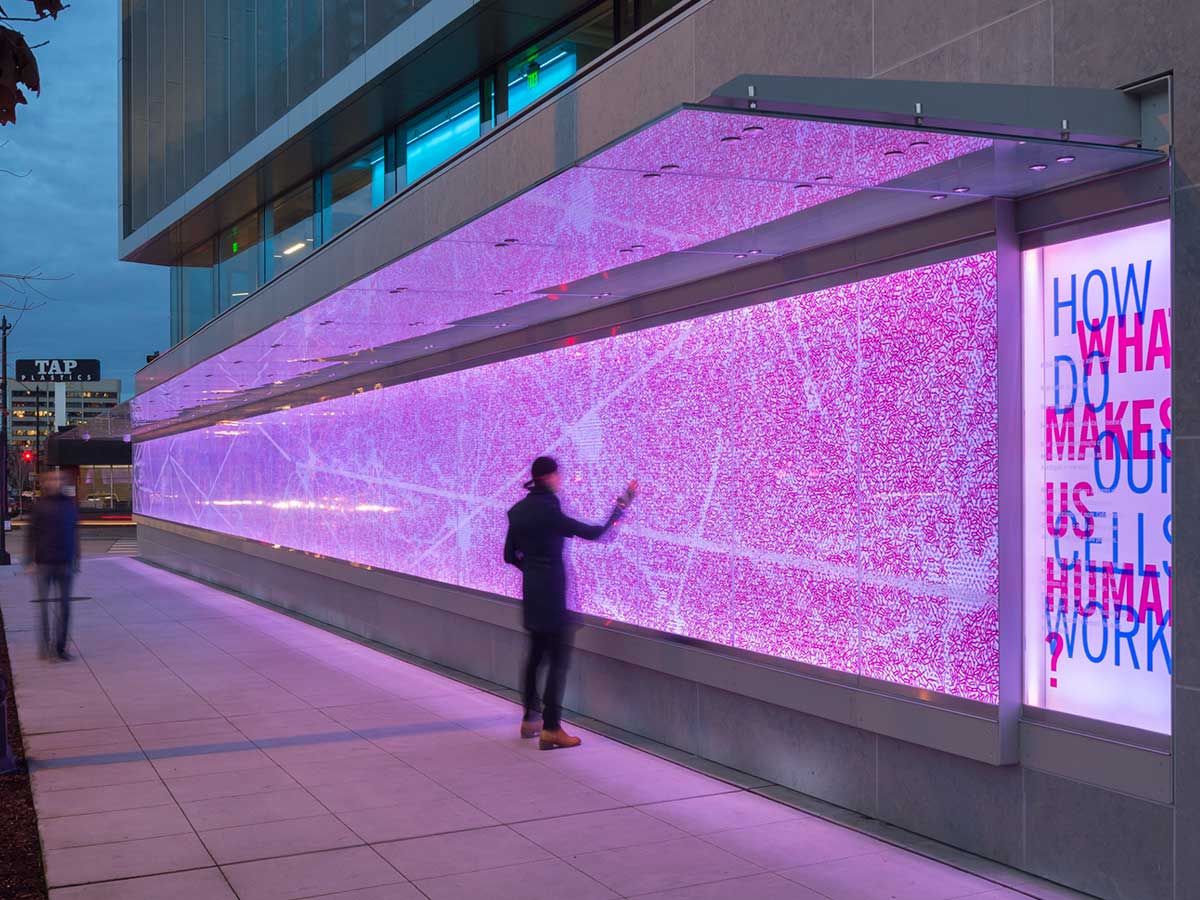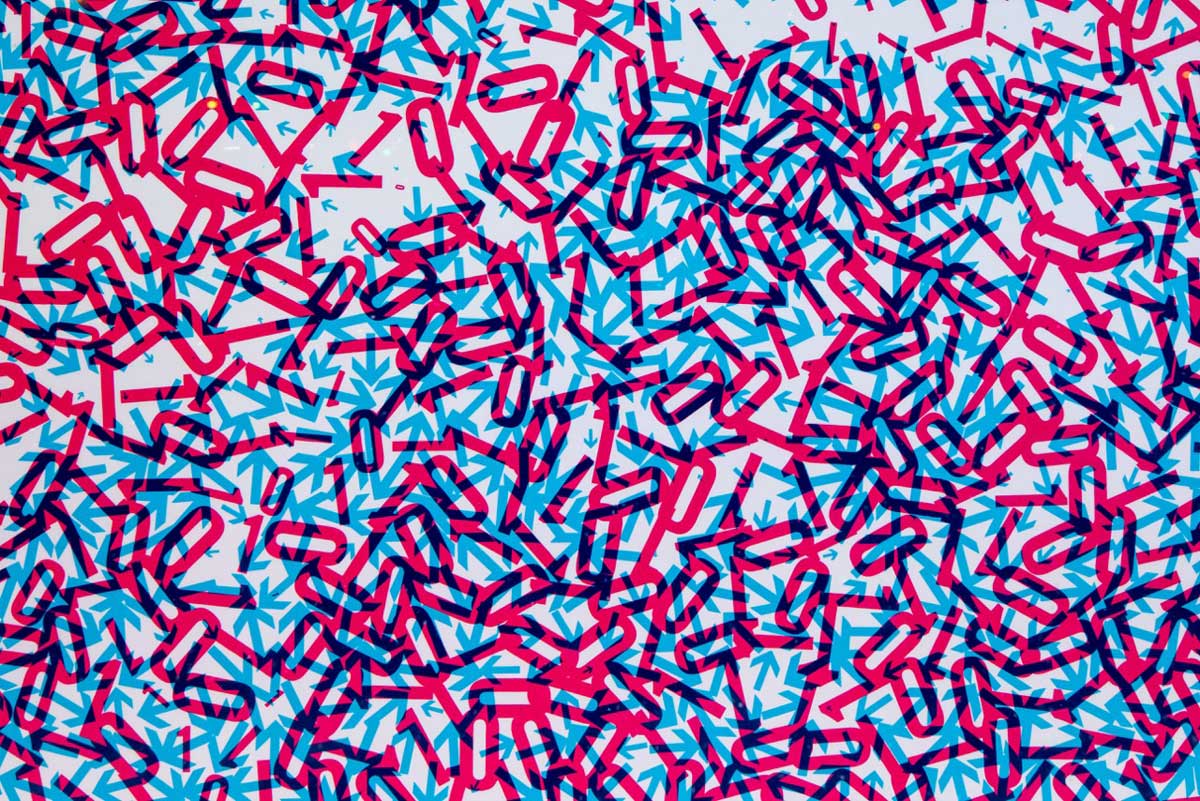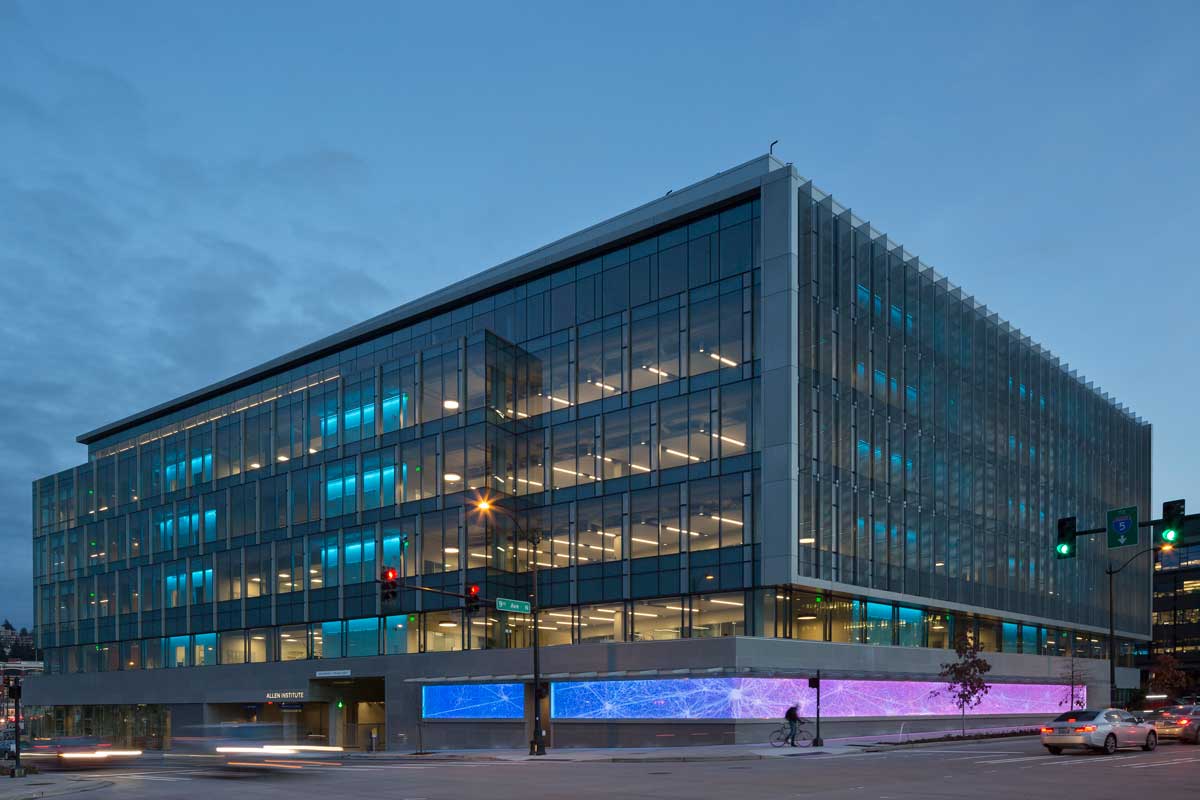Blog
Art Interprets Science: Pathways
Pathways at the Allen Institute for Brain Science
By Suzanne Beal Shaw

Think you know your own mind? You’ve almost certainly never seen your brain from this angle. Pathways, a new public art piece in the heart of South Lake Union, takes its cue from the goings-on within the building it’s attached to. In the process, it creates a sense of wonder and curiosity: both about the Allen Institute for Brain Science and the complexity of the human mind itself.
In 2015, the Allen Institute announced its move from Fremont, where the organization was spread among several buildings, to a single 245,000-square-foot structure at the northwest corner of Mercer Street and Westlake Avenue North. The new building doesn’t just enable the institute to consolidate operations. It also gives passersby an insider’s view of the complex and collaborative nature of this scientific nonprofit. Although Pathways, the 150-foot-long graphic created by Studio SC, doesn’t exactly replicate how neurons function, it does interpret the brain’s activity in a way that also describes the institute’s approach to brain science.
There are almost a 100 billion neurons in the human brain. With no two exactly alike, it’s one of the most complex pieces of organized matter in the known universe. In order to understand how the brain functions, the institute must not only determine the brain’s myriad individual components, but also how these components interact with one another.
With the world’s most advanced tools at their disposal, the institute is able to see matter invisible to the naked eye. The institute’s researchers have spent years examining micro-thin anatomical cross sections of the brain in order to detail the growth, the white matter, the function of specific cells, and the independent connections of every gene expressed therein. Using custom-designed robotic systems, specialized technologies, and high-powered computing hardware and software designed to process the densest data to date; they’re literally reading minds. Studio SC’s Pathways brings a poetic translation into the public eye.

Neurons “fire,” or connect and disconnect with each other to pass information along—and in the process create information conduits. Pathways uses actual neural imagery to interpret the vast complexity of brain anatomy and activity occurring at any given moment. Densely grouped arrows, numbers and typographic letterforms create long, lean stretches of mental highways that intersect in starbursts before streaming out again. But it’s in observing the work up close that the smaller marks used within the negative space of Pathways’ bands of color reveal themselves. The payoff for this attention to detail is huge. The symbols used reflect three core areas given broad play at the institute: neural pathways observed in the form of arrows; computational analysis in the form of binary code; and language inference in the form of letters. Taken together they form a snapshot of the brain in action.
In the first few seconds of vision, the brain uses a network of cells to convert light signals at the retina into pieces of data. “So there is a difference between what your eyes receive and what your brain sees,” explains Michael Buice, Ph.D. and Assistant Investigator at the Allen Institute for Brain Science.
Come night, Pathways transforms the busy South Lake Union corner and its glass awning into a provocative light show, in which the firing of neurons takes center stage. Pathways’ pre-programmed LED light sequences rely on image density to create a sense of movement. Once activated, its static printed graphics appear to change location, mimicking a blast of neural energy along the length of the wall. Shifting in color from red to blue to white, different patterns emerge—patterns that were invisible to the naked eye just a moment ago.
Look hard enough and you might think you see hidden meaning. Then again, it could just be your mind playing tricks on you.
Vision must rely on context at all levels. In order to recognize an object, the brain separates those features that define it from those that do not. Without this type of separation, all is reduced to a terrifying gobbledygook. Just as Virgil guided Dante through the dim, dark, mysterious netherworld in “Inferno”, Pathways offers up visual cues to pedestrians, allowing them a better understanding of how the brain creates order out of chaos. “The brain has an extremely difficult job,” says Buice. “It is responsible for governing behavior in response to a highly variable and uncertain world.”
But Pathways does more than simply offer a re-creation of the brain’s activity. The institute uses guiding principles like team science, big science and open science to accelerate research worldwide through public releases of new data, knowledge and tools. In this light, Pathways’ directional arrows can be read as the global distribution of information; letters as bridging communication between scientific partners; and binary code as the institute’s state-of-the-art methods of investigating and documenting the brain via high-throughput computers. The title itself, Pathways, is applicable to a variety of different concepts. It at once references the neural pathways inside the brain, the paths forged within the science community, and its very placement within a highly trafficked area of one of the quickest growing neighborhoods in the city.
Pathways allows the general public to grasp the big ideas behind the brain. While passersby can’t physically access the institute, an exterior wall panel serves as shorthand to describe the complex developments inside: “Within these walls, we ask questions. What makes us human? How do our cells work? How can we better understand disease? What hidden breakthroughs can we discover if we take risks and investigate in new ways?” Profound questions that the institute is endeavoring to answer. But it’s Pathways, in silent proximity, which materially embodies the institute’s aspirations: allowing scientists and non-scientists alike to consciously witness their own curious minds at work.

Photos (top, bottom) courtesy of Lara Swimmer Photography
Photo (center) courtesy of Gudmundur Ibsen Photography
Published on 12 May 2016